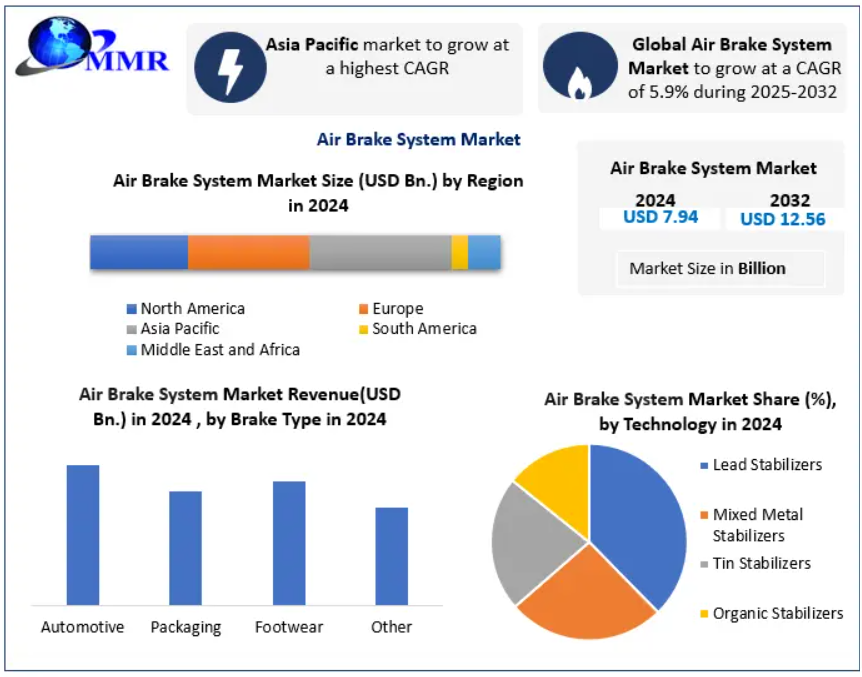Air Brake System Market Revenue Forecast and Opportunities 2025-2032

Global Air Brake System Market – Industry Outlook & Forecast (2025–2032)
The Global Air Brake System Market size was valued at USD 7.94 billion in 2024 and is projected to reach USD 12.56 billion by 2032, growing at a CAGR of 5.9% during the forecast period.
Air Brake System Market Overview
Air brake systems are critical safety components widely used in commercial vehicles, railways, aircraft, and heavy equipment. Their reliability, fail-safe mechanisms, and ability to handle high loads make them indispensable in trucks, buses, semi-trailers, mining machinery, and high-speed trains.
The market growth is fueled by:
- Strict safety regulations (e.g., Euro 7 in Europe, FMVSS 121 in the U.S.) mandating ABS and EBS integration.
- E-commerce expansion, driving demand for logistics and freight fleets.
- Electrification and autonomy trends, leading to smart braking systems with regenerative and AI-powered functionalities.
- Adoption in railways and aerospace, enhancing safety and operational reliability.
While Asia Pacific dominated in 2024, North America and Europe lead in the adoption of next-gen electronic braking systems, reflecting advanced infrastructure and regulatory standards.
To know the most attractive segments, click here for a free sample of the report:https://www.maximizemarketresearch.com/request-sample/23941/
Air Brake System Market Dynamics
Drivers
- Rising Commercial Vehicle Demand: Growth in logistics, mining, and construction boosts adoption of durable braking systems.
- Technological Advancements: AI-based electronic braking, predictive maintenance, and regenerative braking enhance performance and safety.
- Railway & Aerospace Demand: Increasing reliance on electro-pneumatic systems for high-speed trains and aircraft.
Opportunities
- EV & Autonomous Vehicles: Growing demand for regenerative and electronically controlled air brakes.
- IoT Integration: Smart monitoring and predictive maintenance reduce downtime, creating efficiency gains.
Challenges
- High Costs: Smart braking upgrades are up to 70% costlier than traditional systems, limiting adoption in cost-sensitive regions.
- Integration Barriers: Legacy fleet compatibility and shortage of skilled technicians pose challenges.
Air Brake System Market Segment Analysis
By Component
- Compressor (dominant in 2024) – Backbone of the system, converting mechanical energy into compressed air.
- Reservoir
- Foot Valve
- Brake Chambers & Slack Adjusters
- Others
By Vehicle Type
- Heavy-Duty Vehicles (largest share) – Trucks, buses, and commercial fleets rely heavily on air brakes for load stability and fail-safe performance.
- Rigid Body
- Semi-Trailer
- Others
By Brake Type
- Disc
- Drum
By Technology
- ABS (Anti-lock Braking System)
- TCS (Traction Control System)
- ESC (Electronic Stability Control)
- EBD (Electronic Brake-force Distribution)
- Others
By Application
- Automotive (buses, trucks)
- Railways
- Aerospace & Industrial Equipment
To know the most attractive segments, click here for a free sample of the report:https://www.maximizemarketresearch.com/request-sample/23941/
Regional Insights
- Asia Pacific (APAC) – Largest market, led by China, India, and Japan. Rapid infrastructure growth and large fleets drive adoption.
- North America – Advanced electronic braking and strong demand in freight/logistics sectors.
- Europe – Early adopter of ADAS and regenerative braking systems under Euro 7 and net-zero mobility goals.
- Middle East & Africa – Growth driven by construction, mining, and fleet modernization.
- South America – Emerging adoption in Brazil and Argentina with expanding logistics and transport.
Competitive Landscape
The market is highly consolidated, with global leaders investing heavily in R&D, automation, and connected braking technologies.
Key Players
- Knorr-Bremse AG (Germany) – Leader in commercial vehicle braking, strong partnerships with Daimler & Volvo, launching AI-based NextGen EBS.
- Wabtec Corporation (USA) – Dominates railway braking, offering IoT-enabled predictive systems like RailConnect™.
- ZF Friedrichshafen AG (Germany) – Focused on integrated braking and regenerative systems for electric trucks.
- Meritor (USA) – Developing hydrogen-compatible braking systems.
- Continental AG, Brembo, Haldex, Aisin, Akebono, Mando, Brakes India – Strong regional and niche market players.
Key Trends
- Electric Vehicle Braking: ZF’s RegenAir™ leads in EV bus braking in Europe, SORL Auto Parts dominates EV trucks in China.
- AI-powered Brakes: Bendix (U.S.) and Knorr-Bremse (EU) reducing stopping distance by 15% in autonomous fleets.
- Silent & Zero-Emission Brakes: Haldex (EU) and Akebono (Japan) launching noise-free, sustainable systems.
- Predictive Maintenance: Wabtec and Knorr-Bremse pioneering IoT-enabled monitoring for railways.
- Hydrogen-Compatible Brakes: Meritor (U.S.) and Aisin (Japan) driving adoption in hydrogen trucks.
Recent Developments
- Knorr-Bremse AG (Germany) – Launched NextGen EBS™ (2025) with AI-driven telematics for autonomous trucks.
- Wabtec Corporation (USA) – Introduced RailConnect™ (2025) for predictive railway brake monitoring, adopted by Indian Railways.
- ZF Friedrichshafen (Germany) – Rolled out RegenAir™ (2025) regenerative braking for electric buses in Sweden.
- Mando Corporation (South Korea) – Developed lightweight electro-pneumatic valves for EV trucks, winning Hyundai contracts.
- Nabtesco (Japan) – Launched automated brake calibration for mining equipment in Australia.
Air Brake System Market Scope
Report Coverage | Details |
Base Year | 2024 |
Forecast Period | 2025–2032 |
Market Size 2024 | USD 7.94 Bn |
Market Size 2032 | USD 12.56 Bn |
CAGR | 5.9% |
Segments Covered | Component, Vehicle Type, Brake Type, Technology, Application, Region |
Conclusion
The Global Air Brake System Market is set for robust growth, fueled by logistics expansion, safety regulations, electrification, and autonomous vehicle adoption. While high costs remain a challenge, innovations in AI, IoT, regenerative braking, and hydrogen-compatible systems are reshaping the competitive landscape.
With Asia-Pacific leading in scale, and Europe/North America advancing in technology, the market is expected to remain highly dynamic, with global leaders like Knorr-Bremse, Wabtec, and ZF Friedrichshafen at the forefront of innovation.
